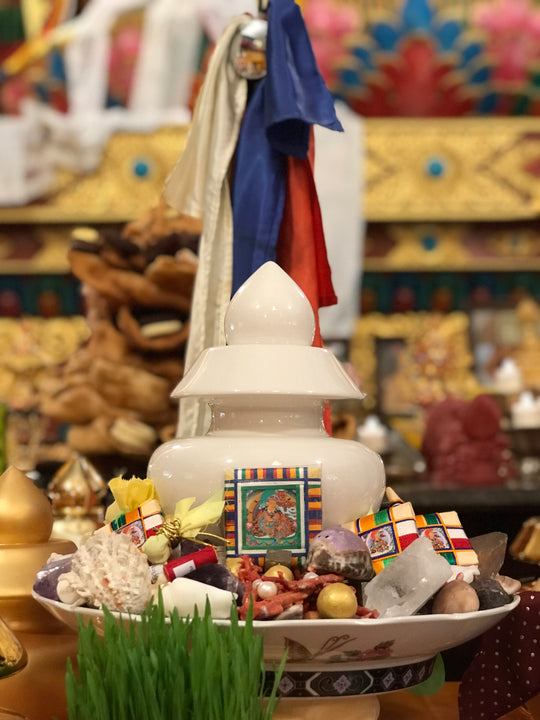Then the Bodhisattva Avalokitevara addressed the Blessed One, "Blessed One, the ten stages of the Bodhisattva are called: - The stage of joy, in which one rejoices at realising a partial aspect of the truth.
- The stage of freedom from defilement, in which one is free from all defilement.
- The stage of the emission of light, in which one radiates the light of wisdom.
- The stage of glowing wisdom, in which the flame of wisdom burns away earthly desires.
- The stage of overcoming final illusions, in which one surmounts the illusions of darkness or ignorance of the Middle Way.
- The stage of the sign of supreme wisdom, in which the supreme wisdom begins to appear.
- The stage of progression in which one rises above the paths of the two vehicles.
- The stage of immobility, in which one dwells firmly in the truth of the Middle Way and cannot be perturbed by anything.
- The stage of all-penetrating wisdom, in which one preaches the Law freely and without restriction.
- The stage of the Dharma cloud, in which one benefits all sentient beings with the Dharma or Law, just as a cloud sends down rain impartially upon all things.
The Ten Stages of the Bodhisattva Path
Stages, or bhumi, is a Sanskrit word for "land" or "ground," and the list of ten bhumis are ten "lands" a bodhisattva must pass through on the way to Buddhahood. The bhumis were important to early Mahayana Buddhism. A list of ten bhumis appears in several Mahayana texts, although they are not always identical. The bhumis are also associated with the perfections, or Paramitas.
The ten bhumis literally mean the "grounds" or levels of Bodhisattvas in which the qualities of their training unfold. With the attainment of the tenth bhūmi, one arrives at and eventually reaches perfection at complete enlightenment.
Many schools of Buddhism describe some kind of path of development. Often, these are extensions of the Eightfold Path. Since this is a description of the progress of a bodhisattva, much of the list below promotes the turning from concern for oneself to concern for others.
In Mahayana Buddhism, the bodhisattva is the ideal of practise. This is an enlightened being who vows to remain in the world until all other beings realise enlightenment.
Here is a standard list taken from the Dashabhumika-sutra, which is taken from the larger Avatamsaka, or Flower Garland Sutra.
Vajragarbha in Tibet is known as Dorje Nyingpo. Vajragarbha is a Bodhisattva who compiled the Dzogchen teachings given by the Buddha Samantabhadra in Akanishtha. He is counted as one of Terton Sogyal's previous incarnations.
The main interlocutor of the Buddha’s entourage throughout many of the Yoginītantras, such as the Hevajra Tantra, is also called Vajragarbha.
Vajragarbha Explains the Ten Bhumis
In the Ten Bhumis chapter, the explanation of the bodhisattva path is given by the bodhisattva Vajragarbha (Dorje Nyingpo). He is empowered by Bhagavat Sakyamuni, whose urṇa hair light rays, called the light of Bodhisattva power, gave him the authorization to teach.
The first few verses of the text, where Vajragarbha explains the qualities of just the first bhumi, Perfect Joy, inform the assembly of Bodhisattvas of the tremendous benefits achieved on that first stage on the path.
They have accumulated good qualities, are endowed with goodness,
Have served the sugatas, are loving, kind, and helpful,
Have a vast motivation, have the pure nature of good intentions,
And develop an unequalled aspiration for the wisdom of the Jinas.
They are diligent in purifying the strengths of the Buddhas and omniscience.
In order to fulfil the Dharma of the jinas and protect beings.
With great kindness, they develop sublime aspiration.
To purify Buddha realms and turn the wheel of the Dharma.
In one instant, they have nonconceptual knowledge of the three times
So that there is the timely purification of various beings.
In brief, they desire all the qualities of the guides.
And develop a vast aspiration equal to space.
They have the power of wisdom, all-preceding compassion, and the employment of method.
They have pure motivation and intention and immeasurable strengths.
They have unimpeded manifestations for others who are to be guided.
They have become the same as the sugatas and have developed the supreme motivation.
Simultaneously with the precious motivation of the sons of the Tathdagatas,
They transcend the conduct of childlike beings and gain the conduct of the Buddhas.
They are born into the family of the ten strengths and do not commit infractions.
They have become the same as the Jinas and will definitely have the highest enlightenment.

Donations for our Buddhist research and development
Do you earnestly cherish our devoted work? Assuming this is the case, we are delighted that you are finding our blog useful and valuable. Would you consider making a donation for our Buddhist research and development?
We need your help to secure the future of scholarly interaction with Buddhism. Since our very first publication of Dharma works and activities in 2008, we have been effortlessly providing free distribution of Dharma posts and articles throughout the previous 14 years. We have exceptionally constrained support and do not receive subsidies or funding from people in general.
Please help us develop our Dharma activities that will not only benefit you but all Dharma readers on the planet. Please consider showing your support. Your generosity will certainly help us enhance our work and accomplish more for a better and brighter future.
Thank you for reading. May you find peace and great bliss. With your support, it helps to spread the Buddha’s precious teachings and turn the Dharma wheels in the world.
Aspiration For Bodhichitta
For those in whom the precious Bodhichitta has not arisen
May it arise and not decrease.
But increase further and further.
Dedication of Merit
By this merit, may we then obtain omniscience then.
Having defeated the enemies wrongdoings
May we liberate migratory from the ocean of existence.
With its stormy waves of birth, old age, sickness, and death.
*Note
I do not own or infringe any copyright on the picture(s).
Picture(s) courtesy and credit to the rightful distributors and/or studios
The picture(s) are intended for editorial use only.





































